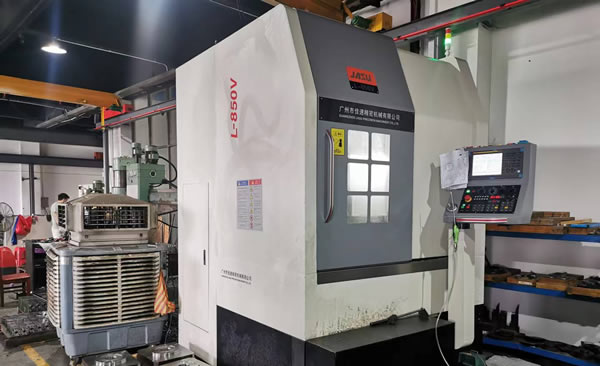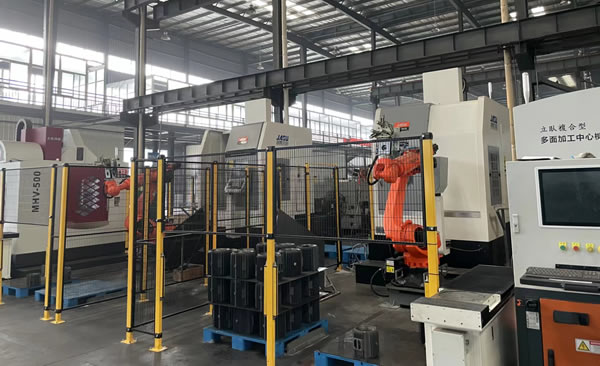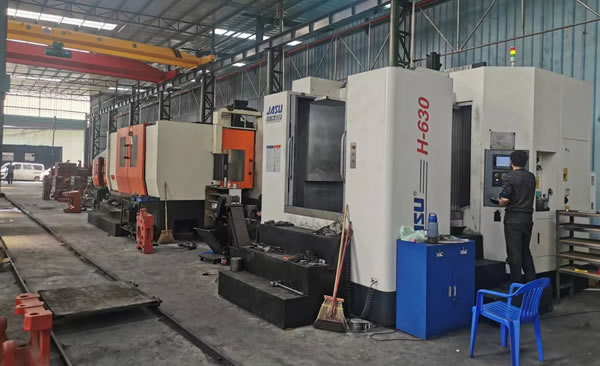1、 Preface
With the continuous development of science and technology, the efficiency of factory parts processing has been greatly improved, but there is still a lot of difference from people's goal requirements, so high-speed cutting has become a hot technology today. As the most important advanced manufacturing technology in mold manufacturing, high-speed machining is an advanced manufacturing technology with high efficiency, high quality and low consumption. A series of problems in conventional machining have been solved by the application of high-speed machining.
High speed cutting technology is based on the full development of machine tool structure and materials, machine tool design, manufacturing technology, high-speed spindle system, rapid feed system, high-performance CNC system, high-performance tool holder system, high-performance tool materials and tool design and manufacturing technology, efficient and high-precision measurement and testing technology, high-speed cutting mechanism, high-speed cutting technology and many other related hardware and software technologies. Therefore, high speed cutting technology is a complex system engineering and a concept that is developing with the development of related technologies.
High speed cutting technology is not only an advanced technology, its development and popularization will drive the progress and efficiency of the entire manufacturing industry. In foreign countries, since Dr. Salomon of Germany put forward the concept of high-speed cutting in the 1930s, after half a century of exploration and research, with the progress of CNC machine tools and cutting tools technology, it began to be applied in the late 1980s and early 1990s and rapidly developed to be widely used in aerospace, automotive, mold manufacturing industries to process aluminum, magnesium alloys, steel, cast iron and its alloys, superalloys, carbon fiber reinforced plastics and other composite materials, The processing of cast iron and aluminum alloy is the most common.
2、 The meaning of CNC high speed cutting In the early 1930s, German physicist Carl J. Salomon put forward a new high speed cutting theory. Through a lot of experimental research, he concluded that: within the normal cutting speed range, if the cutting speed is increased, the cutting temperature will rise, which will aggravate the wear of cutting tools; However, when the cutting speed increases to a certain value, as long as the turning point is exceeded, the cutting temperature will not increase but will decrease as the cutting speed increases. Therefore, as long as the cutting speed is high enough, the problem that the cutting temperature is too high and tool wear is not conducive to cutting can be well solved, and good machining benefits can be obtained.
Later, with the development of the manufacturing industry, this theory was gradually paid attention to and attracted a lot of research attention. On the basis of this theory, the research field of CNC high speed cutting technology was gradually formed. The research of CNC high speed cutting technology in developed countries was relatively early, and it has gone through theoretical basic research, application basic research, application research and development application. At present, it has entered the substantive application stage in some fields.
As for the category of high speed cutting, there are several ways to divide it. One is to consider that the cutting speed is 5-10 times higher than the conventional cutting speed, which is called high speed cutting. Some scholars also take the spindle speed as the standard to define high-speed machining, and think that high-speed machining is when the spindle speed is higher than 8000 r/min. From the perspective of machine tool spindle design, it is defined by the product DN of spindle diameter and spindle speed. If the DN value reaches (5~2000) × 105mm. R/min, it is considered as high-speed machining. In production practice, different machining methods and materials lead to different high-speed cutting speeds. Generally speaking, turning speed reaches (700~7000) m/min, and milling speed reaches (300~6000) m/min, which means high-speed cutting.
In addition, considering the actual production, the concept of high-speed cutting not only includes the high-speed of the cutting process, but also includes the integration and optimization of the process. It is a high-speed cutting process that can obtain good economic benefits, and it is the unity of technology and benefits.
3、 Characteristics of high speed cutting machine tools
1. The production efficiency has been significantly improved
High speed machining allows the use of larger feed rates, which are 5-10 times higher than conventional machining, and the material removal rate per unit time can be increased by 3-6 times. When machining parts that need a large amount of metal removal, the processing time can be greatly reduced.
2. Cutting force reduced by 30%
Because high-speed cutting adopts very shallow cutting depth and narrow cutting width, the cutting force is small. Compared with conventional cutting, the cutting force can be reduced by at least 30%. This can reduce machining deformation for parts with poor machining rigidity, making it possible to cut some thin wall fine workpieces.
3. Improved processing quality
Because the excitation frequency of tool cutting is far away from the natural frequency of the process system when rotating at high speed, it will not cause forced vibration of the process system, thus ensuring a better processing state. Because the cutting depth, cutting width and cutting force are very small, the tool and workpiece deformation is small, the dimensional accuracy is maintained, the cutting failure layer is thinner, the residual stress is small, and high-precision and low roughness machining is realized.
From the perspective of dynamics, the frequency formation shows that the reduction of cutting force will reduce the amplitude of vibration (i.e. forced vibration) generated by cutting force; The increase of rotating speed makes the working frequency of the cutting system far away from the natural frequency of the machine tool and avoids the occurrence of resonance; Therefore, high-speed cutting can greatly reduce the surface roughness and improve the machining quality.
4. Reduce processing energy consumption and save manufacturing resources
Due to the high metal removal rate per unit power, low energy consumption and short time in production of the workpiece, the utilization rate of energy and equipment is improved, and the proportion of cutting in the total resources of the manufacturing system is reduced, meeting the requirements of sustainable development.
5. The processing process is simplified
Conventional cutting cannot process quenched materials, and quenching deformation must be manually repaired or solved by electric discharge machining. High speed cutting can directly process hardened materials. In many cases, it can completely eliminate the electrical discharge machining process, eliminate the surface hardening problem caused by electrical discharge machining, and reduce or eliminate manual finishing.
4、 Problems in High Speed Cutting
From a practical point of view, people's understanding of high-speed cutting is not very comprehensive, so the technology is not very advanced and perfect, and there are still many problems to be solved without reasonable solutions. Even in Switzerland, Germany, Japan and the United States, where the level of metal cutting machine tools is advanced, the research and application of new high cutting technology is still in the process of continuous development, The following is an analysis of the problems in the practical application of high-speed cutting.
1. Processing parameters cannot be reasonably selected
As a new cutting force mode, there is no complete parameter table to choose from, nor many machining examples for reference. At present, most of high-speed cutting still depends on past experience or a large number of experiments to select parameters, which cannot achieve very accurate results. Therefore, how to choose reasonable processing parameters to achieve the best cutting effect is a very important problem in the application of high-speed cutting. At the same time, because the tool path formed by high-speed cutting requirements should be as smooth as possible, with fewer turning points and no sharp break points, the program algorithm should meet the special requirements of high-speed cutting.
In case of interference, it can be adjusted quickly to ensure reasonable feed speed Avoid tool vibration, etc. In the current manufacturing process, the tool path planning method does not consider the particularity of high-speed cutting, so the traditional tool path must be optimized to suit high-speed cutting.
2. Suitable tools and solutions
High speed cutting tool technology is the key technology of high speed cutting. The current development of tool materials cannot meet the needs of various fields. The matching problem between tool materials and workpiece materials has greatly affected the development of high speed cutting. The lack of proper tool selection scheme is a key problem in the popularization and application of high-speed cutting. Because the cutting mechanism of high-speed cutting is completely different from that of traditional cutting, the wear mechanism and failure form of machining, the stress condition of the tool, and the chip shape formed are different. In high-speed cutting, its failure forms are completely different according to the processing conditions and different workpiece materials, such as tool tip breakage, simultaneous wear of front and rear tool faces, tool bar breakage and other forms, and different tools and different workpiece materials have different effects. How to choose reasonable high speed cutting tools, extend the service life of tools as much as possible, and maximize the performance of tools is a very critical technology for high speed cutting applications.
3. Research on high-precision control of Daimar and difference compensation When machining complex contours with high-speed cutting, it is required to maintain a regular and uniform speed, and no obvious lag phenomenon is allowed, otherwise the tool will be burned. In general machining and manufacturing and related CAM software, when processing the NC program of the contour, there will be obvious lag phenomenon in the part with large curvature change, in order to ensure the interpolation accuracy. At present, there is an irreconcilable contradiction between the calculation amount and the interpolation accuracy in the interpolator. On the one hand, in order to improve the accuracy, the interpolation step size must be refined, and the refinement of the interpolation step size brings a huge amount of calculation, limits the program running cycle and reduces the running speed. Due to the fact that the current linear and circular arc seeders cannot meet the requirements of high accuracy, a new type of CNC corrector must be developed.
In addition to the above problems, such as the overall dynamic and thermal characteristics of high-speed cutting machine tools, the problems between tool materials, geometric angles and tool life, and the selection of cooling and lubricating fluids, are all problems that need to be studied and solved. Only by considering high-speed machining machine tools as a whole can high-speed cutting play a huge role.
5、 Development status of high speed cutting technology in china
The development of high-speed and ultra-high speed grinding in China has been promoting high-speed grinding technology since 1958. In 1964, the Institute of Abrasive Grinding (Third Grinding) cooperated with Luoyang Tractor Factory to conduct a 50 m/s high-speed grinding test, and achieved certain results in machine tool modification and process. In October 1975, Henan Nanyang Machine Tool Factory successfully trial produced MS132 80m/s high-speed cylindrical grinder. In 1976, Shanghai Machine Tool Works, Shanghai Grinding Wheel Works, Zhengzhou Institute of Abrasive and Abrasive Tool Grinding, etc. formed a high-speed grinding test group to conduct an experimental study on the high-speed grinding process at 80 and 100 m/s. In October 1982, Hunan University carried out an experimental study on the 60 m/s high-speed powerful cam grinding process, which provided experimental data for the development of high-speed powerful camshaft grinding machines and high-speed powerful grinding wheels. By 1995, Hanjiang Machine Tool Works had conducted a 200 m/s ultra-high speed grinding test with ceramic CBN grinding wheels. Guangxi University has carried out the experimental research on the grinding of 80m/s high-speed low surface roughness around 1997.
At the 2000 China CNC Machine Tool Exhibition, Hunan University launched a CNC camshaft grinder with a maximum linear speed of 120m/s. Since 2002, Hunan University has begun to conduct high-speed and ultrahigh speed research on the spindle system of a 250m/s ultrahigh speed grinder, and has designed the magnetic bearing for the first time in China.
Since the 1990s, Northeastern University has been carrying out research on ultra-high speed grinding technology, and first developed the first ultra-high speed test grinder in China with a circumferential speed of 200 m/s, a rated power of 55 kw, and a maximum grinding wheel linear speed of 250 m/s. Northeastern University has successively carried out research on the heat transfer mechanism of ultra-high speed grinding, high-speed single particle grinding mechanism, design and manufacture of 200m/s plated CBN ultra-high speed grinding wheel, research on the temperature field of ultra-high speed grinding, research on the grinding friction coefficient, research on the air flow on the surface of ultra-high speed grinding wheel, and molecular dynamics simulation of ultra-high speed grinding mechanism, and has made gratifying research results, some of which have reached the international advanced level.
The high-grade CNC system and open CNC system of high-speed machine tools are under in-depth research, but at present they mainly rely on imports. At present, high-speed cutting technology is gradually being popularized and applied in China, mainly in aerospace, mold and automobile industries. There are many aluminum alloys and cast irons processed, but the tools used are mainly imported. At present, domestic tool materials are still dominated by high-speed steel and cemented carbide tools. Although advanced tool materials (such as coated cemented carbide, cermet, ceramic tools, CBN and PCD tools, etc.) have a certain foundation, they are not widely used. In general, the cutting speed is generally low, and the cutting level and processing efficiency are low. The research on the basic theory of high-speed cutting started late. Since the 1980s, the domestic has systematically studied the rules of chip formation, cutting temperature, cutting force, tool wear and breakage, tool life and machined surface quality during high-speed hard cutting with ceramic tools, and has been widely used in production.
Since the 1990s, the cutting force, cutting temperature, tool wear and breakage and tool life of high-speed cutting aluminum alloy, steel, cast iron, superalloy, titanium alloy, etc. have been studied and discussed, but no comprehensive and systematic research has been carried out. There are many researches on the monitoring technology of cutting process, but few are put into production.
6、 Development trend of high speed cutting technology
The development trends and future research directions of high-speed cutting technology can be summarized as follows:
(1) Based on high-speed cutting technology, develop and promote dry (quasi dry) cutting green manufacturing technology;
(2) Research on dynamic characteristics and stability of high speed cutting;
(3) Deep research on high speed cutting mechanism;
(4) The development of a new generation of tool materials with good thermal vibration resistance, wear resistance and long service life, and the research of tool structures suitable for high-speed cutting;
(5) Further expand the scope of high-speed cutting workpiece materials and high-speed cutting technology;
(6) Develop monitoring technology suitable for high-speed machining status;
(7) Establish a high-speed cutting database and develop programming technology suitable for high-speed cutting to further promote high-speed cutting technology;
(8) Based on high-speed cutting, develop and promote high-energy machining technology.
7、 Conclusion
From today's industrial development, we can see that the industrial level is becoming more and more advanced, China's manufacturing industry is becoming stronger and stronger, and we have gradually become a powerful industrial country. High speed cutting technology is a very advanced technology and has a very good prospect. It can drive the new development of industrial society. Therefore, for the research of high-speed cutting, we should work hard. Only by constant innovation and reform can the industry develop more rapidly!
Related Articles
Related Products

...
Product Details

...
Product Details

...
Product Details

...
Product Details